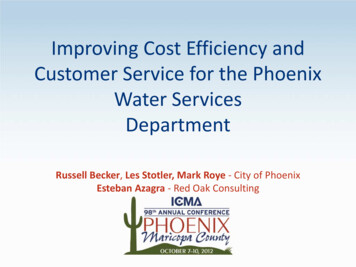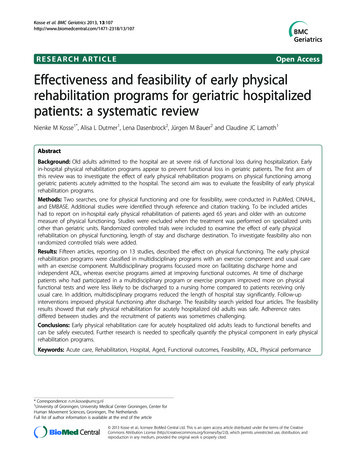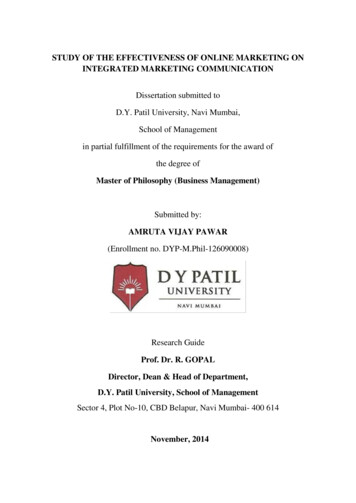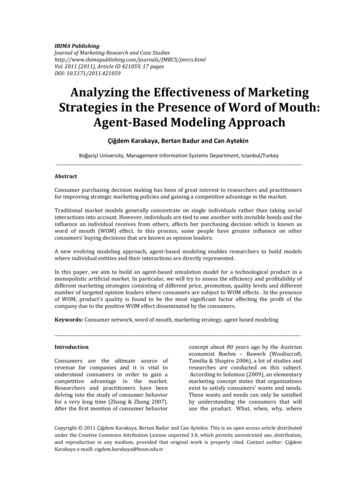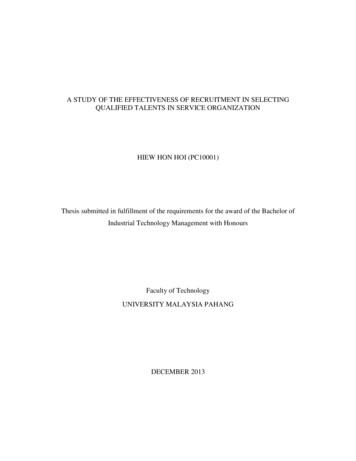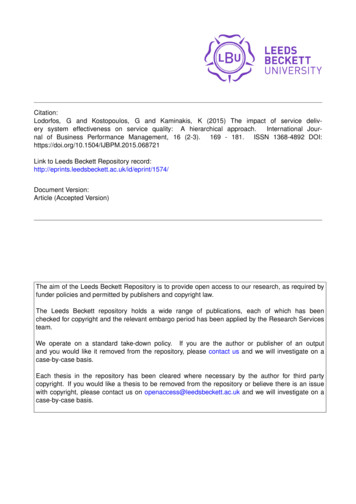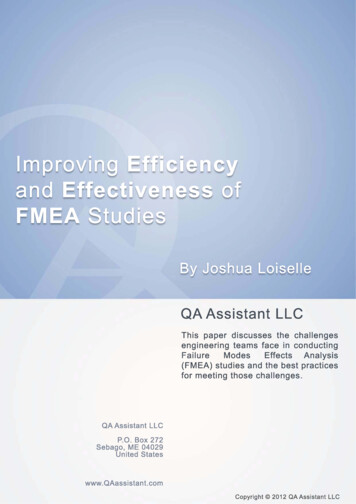
Transcription
Improving Efficiency and Effectiveness of FMEA StudiesContentsExecutive Summary . 2Benefits of conducting effective FMEA studies . 2FMEA challenges created by lack of clarity . 3Planning – Defining the scope of the study . 3Planning – Identifying the team . 4Structuring the approach & managing time . 4Leveraging existing knowledge . 6Continuous improvement & action follow-up . 6Additional post-study challenges . 6Meeting challenges through efficiency, structure and automation . 7The spreadsheet approach . 7Preferred solution for efficient and effective FMEA studies . 7Conclusion . 8About QA Assistant LLC. 8Web: www.QAassistant.com US Phone: (1) 978-631-0424 EU Phone (UK): 44 (0)20 881 6767 8 EU Phone (IE): 353 (0)1 443 4322Page 1
Improving Efficiency and Effectiveness of FMEA StudiesExecutive SummaryThis paper discusses the challenges engineering teams face in conducting Failure ModesEffects Analysis (FMEA) studies and the best practices for meeting those challenges. Thispaper focuses on the specific topic of improving the efficiency and effectiveness of FMEAstudies.Modern economic needs and increased business competition require engineers toconstantly develop newer and better solutions within shorter timeframes and tighter margins.In addition, documentation requirements for meeting standards / regulatory compliance andcustomer needs are becoming increasinglycomplex and verbose. Managing open actionsFMEA studiesand continuous improvement activities acrosssignificantly reduce costsall projects, product variations, and processesin addition to daily engineering tasks isand improve productivitytime consuming, and iswhen properly conducted. cumbersome,susceptible to errors, omissions, and nonconformances.FMEA studies are proven methods for improving products and processes whilesubsequently reducing engineering workload and improving machine and resourceavailability through a preemptive, systematic approach of identifying, analyzing, andimproving high-risk components. If implemented correctly, FMEA studies significantlyreduce costs and improve productivity.However, the value of an effective FMEA is often shrouded by a lack of clarity and structure,misconceptions, and previous experiences and, as such, FMEA studies are frequentlygrouped with the other required information and documented retrospectively in preparationof customer requirements or audits. Performing studies in this way only adds cost to aproject and perpetuates the misnomer that FMEA studies are not value-added activities.This paper discusses the benefits of effective FMEA studies, the challenges related toconducting FMEA studies, best practices for efficiently overcoming challenges via structureand automation, and the benefits of implementing those practices.Benefits of conducting effective FMEA studiesThe goal of completing effective FMEA studies is to improve products and processesthrough a systematic approach of reducing risk and the limiting opportunities forproduct/process failure. Effective FMEA studies are powerful tools that benefit theorganization, customers, and end users by:9 Improving yield and profit margins9 Reducing time to market9 Increasing machine and human resource availability9 Ensuring employee and customer safety9 Meeting industry specific standards compliance and customer requirementsWeb: www.QAassistant.com US Phone: (1) 978-631-0424 EU Phone (UK): 44 (0)20 881 6767 8 EU Phone (IE): 353 (0)1 443 4322Page 2
Improving Efficiency and Effectiveness of FMEA Studies9 Identifying necessary controls and developing test procedures9 Supporting due diligence claims in legal disputesCompleting FMEA studies efficiently has the additional benefits of freeing up valuableengineering time, reducing the ‘cost of quality’, and most importantly, obtaining the teambuy-in which likely ensures studies will be conducted more regularly and helps drivecontinuous improvement activities.As well as being a reliable tool for preventing potential risks in the subject design or process,the process of developing an FMEA provides the environment to identify improvements forsimilar designs and processes. Cost savings across multiple product lines may be realizedwhile conducting a single FMEA study.FMEA challenges created by lack of clarityWhile developing products and processes, engineers instinctively plan for potential physicaland financial risks which may jeopardize a design. Although FMEA is simply a method forengineers to document their thought process and the FMEA’s logical flow itself lendsnaturally to the engineering environment, there is still a reluctance and tendency to postponeFMEA studies; But why?Planning – Defining the scope of the studyThe FMEA process can be daunting and out of the comfort zone for engineers. FMEAdocuments created after a project is complete may expose weaknesses in the product orprocess design which is frustrating for the teamwho invested so much time. Poorly definedAn FMEA study’s timingdocument scopes, unsuitable team selection, andand clear scope play aa general misunderstanding of the FMEA processalso contribute to weak study results and acritical role in itsdiscouraged team. An FMEA study’s timing andsuccess.clear scope play a critical role in its success.Conducting the FMEA prior to a project and reviewing it as the project progresses will saveyour team time, help reduce development costs, and will be seen by the team as a valueadded support rather than a hindrance.In the past, FMEAs were expected to be an extensive document detailing every aspect of aproduct design or process. In the modern approach, there is far more flexibility in thefunctionality of the study. Existing ‘family level’ FMEA documentation, for example, mayaddress a broad range of products or processes. Certain components of the product oraspects of the process which are considered extremely low-risk or trivial may beunnecessary to detail. Therefore, the scope of the FMEA may be defined to focus only onpotential high-risk aspects of the design or process such as a new technology, safety criticalfeatures, or complex components which merit additional thought and preparation. Defining aWeb: www.QAassistant.com US Phone: (1) 978-631-0424 EU Phone (UK): 44 (0)20 881 6767 8 EU Phone (IE): 353 (0)1 443 4322Page 3
Improving Efficiency and Effectiveness of FMEA Studiesmanageable scope will gain team support and help focus efforts on the areas of greatestconcern.Planning – Identifying the teamThe document scope plays an integral role in determining the appropriate team. While anFMEA team may include representation of the customer requirements, key disciplinesinvolved in the product or process design and implementation, test engineering, reliabilityengineering, and/or quality engineering, only people directly involved in the product orprocess in the scope of the FMEA should beinvolved in its creation."The more; the merrier"does not apply toFMEA team selection"The more; the merrier" is not an applicable phrasewhen it comes to selecting an FMEA team. If a teamhas too many members, it may limit individualcontributions and inspire impertinent conversationswhich removes focus from the task at hand and leads to longer study completion times.Before an FMEA revision or version is finalized, consider sending it to the team members forapproval. Including the team in the approval process gives ownership of the document tothe team, reminds relevant team members of open actions, and demonstrates to the teamthat their input is valuable.Structuring the approach & managing timeEven with a properly defined document scope and a well assembled team, a significantamount of time is often lost during the ‘brainstorming’ process – when the team isresearching and documenting the information for the study. The researching process isoften unstructured, manual and dependent solely on the experiences and expertise of thecurrent team members. Data entry may also be tedious and slow using traditionalspreadsheet templates.Structured approachAn unorganized approach to an FMEA study (i.e. filling in fields in a random order, poorpreparation, etc.) leaves the study vulnerable to erroneous or incomplete information. Even ifa systematic approach is adopted, the selected method plays an instrumental role in theteam’s performance – quality, quantity, and pace.To demonstrate the variance in potential productivity depending on the chosen method,consider the following table. If the table is completed one item at a time, entering the sizeand color before moving on to the next item, the thought process must shift from column tocolumn which slows down the pace of the document. To illustrate the amount of time ittakes, complete the table below using this first method – entering a vegetable, its size, itscolor; then enter another vegetable, its size, and its color; and so on.Web: www.QAassistant.com US Phone: (1) 978-631-0424 EU Phone (UK): 44 (0)20 881 6767 8 EU Phone (IE): 353 (0)1 443 4322Page 4
Improving Efficiency and Effectiveness of FMEA StudiesCategoryVegetablesItemSizeColorLarge AnimalsItems found in theofficeThe efficiency of the team may be significantly improved by altering the approach. Todemonstrate how productivity may be improved, complete the following table one column ata time instead of row by row. For example, list three types of fruit, then list the size of each,then the color of each fruit. Then list three small animals, then the size of each, then theircolor.CategoryFruitsItemSizeColorSmall AnimalsItems found at homeThe same principle may apply for creating FMEA documents. For example, start by listingthe various items or process steps. This may be done quite effectively by reviewing theproduct diagram or process flow. Next, determine all of the failure modes for each of thepreviously listed items or process steps, indicating the severity of each. The potential causesfor each failure mode should then be listed. Utilizing this method to complete the documenthelps keep the team focused and maintains the flow of the document.Keeping the team focused on similar types of information will improve their performance. Byfollowing this second method, not only should the pace of the document increase, theinformation entered for each column should be more consistent, as well.Managing timeWith a well-selected team, the ideas should flow steadily. Spending too much time on aparticular entry may disrupt the pace of the document and result in longer study completiontimes. Often the cause of delays is due to a lack of available information or lack of detail.Where additional information is required but not currently available, it is recommended tomaintain the team’s momentum by simply assigning an action to complete the information ata later time and moving on to the next entry.Web: www.QAassistant.com US Phone: (1) 978-631-0424 EU Phone (UK): 44 (0)20 881 6767 8 EU Phone (IE): 353 (0)1 443 4322Page 5
Improving Efficiency and Effectiveness of FMEA StudiesLeveraging existing knowledgeWhile ‘brainstorming’ is important for identifying and discussing new ideas, there's no needto "re-invent the wheel" when documenting existing knowledge in FMEA studies. Time maybe saved by reviewing other documents created for similar products and processes. Usingpreviously created documents as a resource will reduce the amount of time spent trying toremember information, will help ensure all relevant information is considered in the currentstudy, and will promote the use of consistent language in the documents in order to convey aclear message and facilitate reporting and future research.Continuous improvement & action follow-upToo frequently, documents are left to collect dust. By regularly reviewing and updating yourFMEA documents, the time to complete the updates may be reduced. This may sound likesomething that is more easilycorrected in theory; however,in practice, there are anumber of effective --whenanotherdocument for the same orsimilar part or process isupdated, at regular reviewmeetings, and when a changehas been made to the part orprocess.Consider reviewing open actions regularly – at weekly meetings, for example. Addressingopen actions with the team provides a forum for discussion. Setting interim targets ormilestones for complex open actions, if applicable, helps make a project manageable andprovides metrics to quantify progress.Graphing key metrics (i.e. ‘average Risk Priority Number (RPN)’ or ‘the mathematicalproduct of Severity and Occurrence’) over time for a particular documen
Existing ‘family level’ FMEA documentation, for example, may address a broad range of products or processes. Certain components of the product or aspects of the process which are considered extremely low-risk or trivial may be unnecessary to detail. Therefore, the scope of the FMEA may be defined to focus only on potential high-risk aspects of the design or process such as a new technology .

